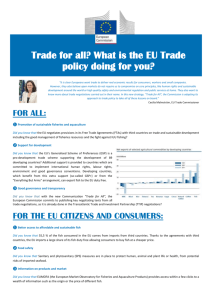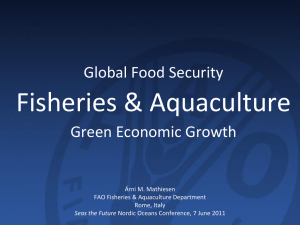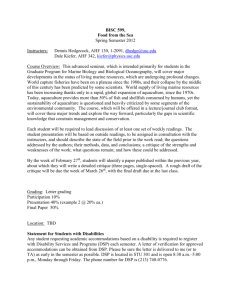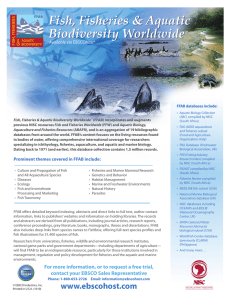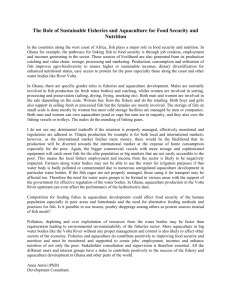Research Journal of Environmental and Earth Sciences 4(1): 34-40, 2012
advertisement
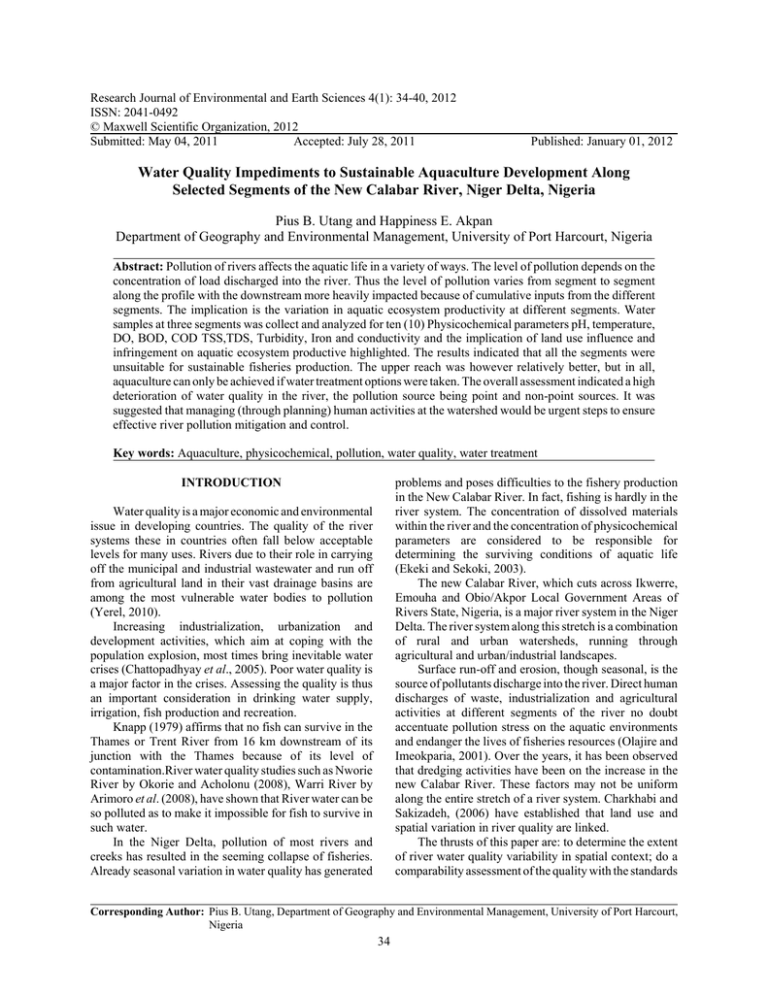
Research Journal of Environmental and Earth Sciences 4(1): 34-40, 2012 ISSN: 2041-0492 © Maxwell Scientific Organization, 2012 Submitted: May 04, 2011 Accepted: July 28, 2011 Published: January 01, 2012 Water Quality Impediments to Sustainable Aquaculture Development Along Selected Segments of the New Calabar River, Niger Delta, Nigeria Pius B. Utang and Happiness E. Akpan Department of Geography and Environmental Management, University of Port Harcourt, Nigeria Abstract: Pollution of rivers affects the aquatic life in a variety of ways. The level of pollution depends on the concentration of load discharged into the river. Thus the level of pollution varies from segment to segment along the profile with the downstream more heavily impacted because of cumulative inputs from the different segments. The implication is the variation in aquatic ecosystem productivity at different segments. Water samples at three segments was collect and analyzed for ten (10) Physicochemical parameters pH, temperature, DO, BOD, COD TSS,TDS, Turbidity, Iron and conductivity and the implication of land use influence and infringement on aquatic ecosystem productive highlighted. The results indicated that all the segments were unsuitable for sustainable fisheries production. The upper reach was however relatively better, but in all, aquaculture can only be achieved if water treatment options were taken. The overall assessment indicated a high deterioration of water quality in the river, the pollution source being point and non-point sources. It was suggested that managing (through planning) human activities at the watershed would be urgent steps to ensure effective river pollution mitigation and control. Key words: Aquaculture, physicochemical, pollution, water quality, water treatment problems and poses difficulties to the fishery production in the New Calabar River. In fact, fishing is hardly in the river system. The concentration of dissolved materials within the river and the concentration of physicochemical parameters are considered to be responsible for determining the surviving conditions of aquatic life (Ekeki and Sekoki, 2003). The new Calabar River, which cuts across Ikwerre, Emouha and Obio/Akpor Local Government Areas of Rivers State, Nigeria, is a major river system in the Niger Delta. The river system along this stretch is a combination of rural and urban watersheds, running through agricultural and urban/industrial landscapes. Surface run-off and erosion, though seasonal, is the source of pollutants discharge into the river. Direct human discharges of waste, industrialization and agricultural activities at different segments of the river no doubt accentuate pollution stress on the aquatic environments and endanger the lives of fisheries resources (Olajire and Imeokparia, 2001). Over the years, it has been observed that dredging activities have been on the increase in the new Calabar River. These factors may not be uniform along the entire stretch of a river system. Charkhabi and Sakizadeh, (2006) have established that land use and spatial variation in river quality are linked. The thrusts of this paper are: to determine the extent of river water quality variability in spatial context; do a comparability assessment of the quality with the standards INTRODUCTION Water quality is a major economic and environmental issue in developing countries. The quality of the river systems these in countries often fall below acceptable levels for many uses. Rivers due to their role in carrying off the municipal and industrial wastewater and run off from agricultural land in their vast drainage basins are among the most vulnerable water bodies to pollution (Yerel, 2010). Increasing industrialization, urbanization and development activities, which aim at coping with the population explosion, most times bring inevitable water crises (Chattopadhyay et al., 2005). Poor water quality is a major factor in the crises. Assessing the quality is thus an important consideration in drinking water supply, irrigation, fish production and recreation. Knapp (1979) affirms that no fish can survive in the Thames or Trent River from 16 km downstream of its junction with the Thames because of its level of contamination.River water quality studies such as Nworie River by Okorie and Acholonu (2008), Warri River by Arimoro et al. (2008), have shown that River water can be so polluted as to make it impossible for fish to survive in such water. In the Niger Delta, pollution of most rivers and creeks has resulted in the seeming collapse of fisheries. Already seasonal variation in water quality has generated Corresponding Author: Pius B. Utang, Department of Geography and Environmental Management, University of Port Harcourt, Nigeria 34 Res. J. Environ. Earth Sci., 4(1): 34-40, 2012 flask was weighed after thorough drying in an air oven and 60 mL of water samples filtered into the weighed flask. The filtrate was evaporated completely by heating on an electric thermal heater/oven, the flask was cooled to room temperature in a desiccators. The flask was reweighed and the weight differential determined. In determining TSS a filter paper was dried in an air oven at 105oC to a constant weight. The filter paper was weighed and recorded, 60 mls of water was filtered through the filter paper and the paper dried until a constant weight was obtained. The filter paper was reweighed when cooled to room temperature in desiccators. TSS was calculated thus: for fish breeding; and assess the suitability of each segment for impoundment for aquaculture. The essence is to suggest possible adaptation measures, given the significant role aquaculture plays in nutrition and sustainable food security. MATERIALS AND METHODS This study was conducted in July 2010. Data on water quality at different segments of the river channel was used. Water quality standards for fisheries were also obtained from relevant literature. The water quality parameters assessed in this study include: pH, Dissolved Oxygen (DO), Biological Oxygen Demand (BOD) and Chemical Oxygen Demand (COD). These are called non conservative parameters (Venkatesharaju et al., 2010). Others including: Total Suspended Solids (TDS), Turbidity, Temperature, and Conductivity (conservative parameters) were also assessed. Three water sampling segments were selected. Water samples were collected along the selected river segments at a point approximately at the middle of the river width at distance or depth above the surface of the river. The distance of sampling from the bank was to ensure that the water samples were free of ruffled up sediment and pronounced human activities. The sampling segments and stations were chosen on the basis of predominant land use contiguous to the river. The sampling points were identified as Locations A, around African Regional Aquaculture Centre (ARAC) in Aluu, with low residential and mainly agricultural activities; Location B, the stretch contiguous with high commercial activities(including the presence of an abattoir), with a mix of medium to high density residential, commercial activities. Location C was at Ogbogoro, downstream of the heavily commercial area, and characterized by medium residential and commercial area, with fishing and farming being the dominant land use. This was chosen to determine the effects of upstream contamination on downstream fishing. The sampling points are shown in Fig. 1. TSS mg/L = Weight of filter paper and residue Weight empty filter paper×1000×20 Spectrophotometer method was used in determining the turbidity. A standard solution of 5NTU was prepared and absorbed. The solution under test was measured in the spectrophotometer and recorded. The turbidity of the test sample was then calculated from the standard thus: 5NTU/Astd×A.S/1 NTU : (Nephelometric Turbidity Units) - Standard Astd : Absorbance of standard AS : Absorbance of test sample The Chemical Oxygen Demand (COD) was determined by permanganate method. 250 mL of sample was measured into a 500 mL conical flask, with 10 mL of KmnO4 and 10 mL of H2SO4 added and the solution turned pink. The mixture was examined at interval and if the previous colour of the permanganate tend to disappear a little further 10 mL KmnO4 was added to maintain a definite excess at the same time a blank was prepared adding to the same volume of the reagents for test sample to 250 mL of distilled water and incubate for 4 h. Ideally the water samples should be analyzed immediately, but because this was not possible, the addition of sulfuric acid (H2SO4) was to preserve the samples (Chapman, 1997). At the end of 4hours l ml of Kl solution was added and the mixture titrated using starch as indicator with 0.0125N, Na2S2O3, 5H2O until the blue colour just disappear the titration was repeated for the blank calculation. Water sampling and laboratory procedures: 1.5 L of water samples were collected from each of the three segments of the river with plastic containers. The containers were thoroughly washed and sterilized to avoid extraneous contamination. All samples were adequately labeled and were taken to the laboratory and stored in a refrigerator at 4ºC to avoid sample loss through evaporation and subsequent concentration of the different parametric indices analyzed. Certain physical parameters such as The acid/alkalinity concentration (pH) and temperature were measured in-situ using hand-held meters, while TDS and TSS were determined by Gravimetric method. In the later case, a 250 mL conical A×VNB - VNS ×1000/Volume of sample VNB : Volume of Na2S2O3 used for blank VNS : Volume of Na2S2O3 used for sample A : Volume of Na2S2O3 used for 10 mL of 0.0725 N KmnO4 35 Res. J. Environ. Earth Sci., 4(1): 34-40, 2012 Fig. 1: Sample points for data collection (Field survey, 2010) Determination of Biological (Biochemical) Oxygen Demand (BOD) was conducted by preparing dilution water by mixing 1 mL of phosphate buffer solution, magnesium sulphate solution and calcium chloride solution in 1000 mL of water. Dilution with distilled water prior to incubation was to prevent the O2 from total depletion, particularly if the organic material concentration in the water sample is very high.The next steps were: Fill 250 mL reagent amber bottle with water sample and pour it into a 500 mL measuring cylinder. Fill the same bottle with dilution water and mix with water ample in the cylinder; Fill the bottle with mix water sample and determine the dissolved oxygen as described in the dissolved oxygen determination. Dissolved oxygen was determined by the modified wrinkler method. Wash the bottle and fill it with the remaining solution of the mixed water sample. Incubate this at 37ºC for 5 days and determine dissolved oxygen as before. Next Calculate DO initial and DO final and finally subtract DO final from DO initial and divide by 0.5. Conductivity as measured by meter method. Analysis of Variance was employed in testing the level of significance of variation in water quality among the parameters and between the sample points. In other words analysis of variance is the approach that allows us to use sample data to see if the value of two or more unknown population means are likely to be different. RESULTS AND DISCUSSION Physio-chemical parameters of the river at upper, middle and lower reaches: The results are presented in Table 1 and graphically represented as in Fig. 2 and 3. The figures show clearly the increasing and decreasing concentration of the impediments to fisheries production across the different sample locations. Specifically, the pH result generally tends to decrease at location C (6.32) and was highest at location A (6.73) with 6.51 at location B. This shows that pH values differ from one location to another along the same stretch of the river. How significant is this difference remains to be unraveled. The lower pH at location C can be attributed to the discharge of organic waste from the beverage factory upstream of the sampling point. Organic waste reduces the pH of water to acidic level (Dublin-Green and Tobor, 1992). Temperature values were highest at location B (26.7ºC) and lowest with 25.8ºC downstream (location C). It is important to note that temperature of water varies Data (statistical) analysis: The parameters were tabulated against sample points to enable the examination of the water quality under various land use with the aim of comparing the values with International standards. Furthermore, this study employed description statistics, such as column graphs to represent the spatial variation of the water quality graphically. 36 Res. J. Environ. Earth Sci., 4(1): 34-40, 2012 Table 1: Physio-chemical parameters concentration at different sections of the New Calabar River and standards for aquatic life S.No. Parameters Location A Location B Location C WHO Standard for aquatic life 1 pH 6.73 6.51 6.32 6.5-90 2 Temp 26.20 26.70 25.00 40ºC 3 DO mg/L 4.00 4.40 5.20 5 mg/L 4 BOD mg/L 10.25 10.40 11.15 5-9 mg/L 5 TSS mg/L 720 760 800 >100<220 mg/L 6 COD mg/L 14.20 14.60 15.52 100 mg/L 7 TDS mg/L 2010 3020 4020 2000 mg/L 8 Turbidity NTU 126.20 128.71 130.90 5NTU 9 Iron mg/L 1.215 -0.190 0.049 1.0 mg/L 380 580 1290 1000 :S/cm3 10 Conductivity :S/cm Field survey, 2010, Chapman, 1997; DO: Dissolved Oxygen; BOD: Biological Oxygen Demand; COD: Chemical Oxygen Demand; TDS: Total Dissolved Solids; TSS: Total Suspended Solid 30 A 25 B 20 C anaerobic condition. Generally unpolluted waters typically have BOD values of 2 mg/L O2 or less, and those receiving wastewaters may have values up to 10 mg/L O2 or more (Chapman, 1997). A high BOD is attributed to input of decomposing organic matter through surface run-off. The result confirms that Location A was better in terms of DO deficiency. The COD was highest at location C (15.52 mg/L) and lowest in Location A (14.20 mg/L) and B (14.60 mg/L). COD is a measure of the oxygen equivalent of the organic matter content of water that is susceptible to oxidation by a strong chemical oxidant. COD is a reliable parameter for guiding the extent of pollution in water (Amirkolaie, 2008 cited in Pejman et al., 2009; Garg et al., 2010). The COD of water increases with increasing concentration of organic matter (Boyd, 1979). The results from this study show that COD was generally within levels expected for unpolluted waters. COD in unpolluted surface water range from 20 mg/L or less (Chapman, 1997). Variation of iron concentration level in the 3 locations ranged from 1.215 mg/L in location A, 0.190 mg/L in location B to 0.049 mg/L in C. The TSS, which relatively measures the physical or visual observable dirtiness of a water resource, was found to be in high at all locations, ranging from 726 mg/L in location A to 760 mg/L in B and 800 mg/L in C. Meanwhile, the TDS value for location C was very high (4020 mg/L) compared to location A (2010 mg/L) and B (3020 mg/L). The Total Dissolved Solids (TDS), which indicate the degree of dissolved substances such as metal ions in the water, were more in location C and lowest at location A. The TDS for all the stations were higher than the standard level of 500 mg/L set by the USA Environmental Protection Agency (Charkhabi and Sakizadeh, 2006) and these indicate the effects of anthropogenic sources along the river, particularly as a result of some improper agricultural activities such as over fertilization. Turbidity result shows that water was more turbid at location C (130.9 NTU) than other locations. This indicates the discharge of surface run-off filled with organic matter (soil, dead leaves etc.,) and other effluents 15 10 5 0 -5 PH Temp DO BOD COD iron Fig. 2: Water quality parameters values at diffent locations 4500 4000 3500 3000 A B C 2500 2000 1500 1000 500 0 TSS TDS TURB COND Fig. 3: Water quality parameters values at diffent locations with time, season and weather; hence temperature at the time of sampling may not a true representation of the prevailing conditions. The concentration of DO was highest in location A was (5.20 mg/L) and progressively decreasing downstream (location B, 4.40 mg/L and A, 4.0 mg/L). Dissolved oxygen concentration more than 5.00 mg/L favours good growth of flora and fauna (Das, 2000 cited in Garg et al., 2010) and varies from one river to another, depending on source and characteristics of discharges (Surve et al., 2005 cited in Garg et al., 2010). The BOD values vary between locations (11.15 mg/L in location C, and 10.25 and 10.10 mg/L for locations B and A, respectively). This shows that the demand generally exceeded the oxygen production and aeration rate, and therefore has effect on the DO deficiency and 37 Res. J. Environ. Earth Sci., 4(1): 34-40, 2012 Table 2: pH tolerance levels and its effect on aquaculture (Lawson, 1995; Tarazona and Munoz, 1995 cited in Chapman, 1997) pH levels Effects on fisheries <4.0 Acid death point 4.0-5.0 No production 6.5-9.0 Desirable range for fish 9.0-11.0 Slow growth >11.0 Alkaline death point 140 A 120 B C Parameter values 100 80 For most freshwater species, a pH range between 5.0 and 9.0 is ideal, thus the optimum value is usually between pH 7.5 and 8.5 (Boyd, 1979). Below pH 6.5 some species experience slow growth (Lloyd, 1992). At lower pH, organism’s ability to maintain its salt balance is affected and reproduction ceases. Thus, the pH level of all the locations does not exceed the acceptable WHO standard for fish production. With this parameter, all the locations could be framework for aquaculture. However, combinations of several environmental factors affect fisheries production. The DO level at all the points are below the recommended standard level making them unfavourable locations for natural fisheries production. Generally, concentrations below 5 mg/L may adversely affect the functioning and survival of biological communities and below 2 mg/L may lead to the death of most fish (Chapman, 1997). Dissolve Oxygen Minimum acceptable level is 5.0 mg/L for reproduction of desirable fish. 5.0 mg/L small fish survive- short exposure, 0.3-1.0 mg/L lethal if exposure is prolonged, and 3.5 mg/L fatal to several fish species within 20 h. From the result of the analysis in the Table 1, the concentrations of the BOD in all sampling points were lower than the WHO values of 5 mg/L, making all of them unsuitable for aquaculture. As noted earlier, unpolluted waters typically have BOD values of 2 mg/L O2 or less, and those receiving wastewaters may have values up to 10 mg/L O2 or more. According to the Japanese Environmental water quality standards, for class I fisheries, BOD is set at less than 1 mg/L, since oligosaprobic fishes such as salmon and smelt require water with a BOD less than 2 mg/L. For class II fisheries, BOD is set at less than 2 mg/L, since mesoprobic fish such as carp require water with a BOD less than 3 mg/L. For class III fisheries, BOD is set at less than 3 mg/L, since class III fisheries require water with a BOD less than 5 mg/L. For class E, conservation of environment, BOD is set at less than 10 mg/L to prevent odor caused by the anaerobic decomposition of organic matter. Since COD was lower than the expected for unpolluted waters, (COD in unpolluted surface water range from 20 mg/L or less) and the values less than the maximum allowable for fisheries production, all the location could be considered fit for fisheries production if only COD is considered. The iron concentration level obtained from the sampling point was 1.215 mg/L for A, 0.190 mg/L for B, 0.649 mg/L for C. The result shows that the value at location A exceeds the 1.0 mg/L standard limit set by the WHO for drinking water and aquatic life; hence the inappropriateness of the water along upstream segment for aquaculture. WHO 60 40 20 0 PH -20 Temp DO BOD COD Iron Turb Parameter/location/standard Fig. 4: Water quality in comparison with WHO standards with high suspended matter content into the river (Chapman, 1997). At location A, the turbidly level was lower (126.20 NTU) than location B (128.71 NTU). This can be due to the difference in dredging activities among the three segments. Conductivity of most freshwaters range from10 to 1000uS/cm, but may exceed this if the water is polluted or receives large quantities of land runoff Chapman, 1997). The level of electrical conductivity for location C (1290 :S/cm) was found to be quiet higher than that of location A (380 :S/cm) and B (580 :S/cm). This may be due to the saline level of location C being brackish water or increase presence of dissolve minerals. It may as well be due to the high pollution load, especially TSS and TDS. Olsen (1950) cited in Garg et al. (2010) classified the name for water bodies having conductivity values greater than 500 :S/cm as eutrophic. The observed conductivity value at location A is 380 :S/cm and falls under the category of mesotrophic water body. According to these criteria the water quality at locations B and C is eutrophic. Comparison of water quality parameters with WHO standards for aquatic life: The comparative values are as presented in Table 1 and graphically depicted in Fig 4. From Table 1, the value for pH at all points were favourable for fish production, as pH between 6.5 and 9.0 is considered the most desirable range for fish, based on established standards. A concentration below this value adversely affects aquatic biological life. The pH range for diverse fish production is 6.5-9, 4.0 acid death point, 4.05.0 no reproduction, 4.0-6.5 slow growth, 11.0 alkaline death point (Ali et al., 2004). The values are shown in Table 2. 38 Res. J. Environ. Earth Sci., 4(1): 34-40, 2012 4500 Parameter values 4000 3500 production of fish than the waters with total solids exceeding 100 mg/L. Total dissolved solids represent total mineral contents, which may or may not be toxic. Low total dissolved solids indicate enough fish diversity while maximum of 400 mg/L is required for maximum fish diversity. The conductivity values (380 :S/cm for A, 580 :S/cm and 1290 :S/cm for C) indicate that location A and B are in accordance to the WHO standard of 1000 :S/cm while that of location C exceeds the stipulated standard. Conductivity measures the capacity of a substance or solution to conduct electric current. The results as depicted graphically in Fig. 5 confirm that TSS and TDS in locations A and B were higher than the standard, while location C had exceedance values for TSS, TDS and Conductivity. This justifies that that this stretch is worst off in natural fisheries production. TSS TDS Cond 3000 2500 2000 1500 1000 500 0 A WHO B C Parameter/location and standard Fig. 5: Water quality in comparison with WHO standards Turbidity values obtained from the entire sampling points were higher than the WHO standard of 5 NTU for survival of aquatic life. The water was more turbid at location C, indicating the concentration of human activities and the influence of season (since the water samples were taken during wet season in July) on the water quality. Runoff causes the settlement of sand, silt and clay resulting in a higher level of turbidity. This hinders the penetration of sunlight into the river making it difficult for the aquatic habitats to receive positive effects of sunlight. Light penetration has inverse relationship with turbidity. Waters with less than 2.5 mg/L turbidity show more light penetration, 12.8 times more planktons and 5.5 times more fish production. While the waters with turbidity exceeding 100 mg/L have low light penetration and fish production. Good waters light penetration is above 600 mm, Satisfactory Light penetration is above 300 mm, while poor waters Light penetration is above 100 mm (Ali et al., 2004). TSS concentrations of 720 mg/L for location A, 760 mg/L for location B and 800 mg/L for location C, show that the TSS value for the entire location were higher than the required standard of 220 mg/L for sustainable fisheries production. The TSS values of the study locations shows that the level of TSS at location C was higher, indicating, high anthropogenic effects on the water quality. More so, this can be due to the direction of river flow, which determines the movement and deposition of dissolved and suspended solids. The concentrations of TDS in the three locations as presented in Table 1 are 2010 mg/L for location A, 3020 mg/L for location B and 4020 mg/L for location C, were all higher than the WHO standard of 2000 mg/L. The TDS for location B and C are quiet higher than the standard while that of location A conforms to the WHO standard for aquatic life. Klein (1992) has reported that the excess amount of TDS in water disturbed ecological balance and cause suffocation of aquatic life. Waters with less than 2.5 mg/L of total solids cause 5.5 times more Implication of water quality for the best stretch for aquaculture: Each stretch of the river differs significantly in terms of obtained physiochemical parameters. The result of the analysis obtained compared with WHO standard shows that all the 3 Locations have significant level of pollution in terms of physiochemical parameters. All the locations can be considered unsuitable for impoundment for aquaculture, given all the parameters except temperature and pH. The pH level recorded during the survey may not affect fish population as these are within tolerable limits. For Dissolved Oxygen, a saturation level of at least 5 mg/L is required. Values lower than this can put undue stress on the fish, and levels reaching less than 2 mg/L may result to death (but 3 mg/L for some species) (Chapman, 1997). The DO levels for the locations indicate differential levels of the degree of pollution by organic materials, the destruction of organic matter and the degree of self-purification of the water at the different locations. The results of laboratory analysis indicate that for this parameter location C is more favourable than the rest for aquaculture. The problem of aquaculture is heightened in location C given the values of Conductivity, which is above the WHO standard respectively for aquatic life. Thus location C is the most inappropriate stretch for fisheries production. In all aquaculture can only be achieved if water treatment options are taken. CONCLUSION Physio-chemical parameters of selected segment of the new Calabar River have been determined in this study. Deleterious levels of almost all the physio-chemical parameters were observed, which stands as a potential health hazard for aquatic ecosystem. 39 Res. J. Environ. Earth Sci., 4(1): 34-40, 2012 Charkhabi, A.H and M. Sakizadeh, 2006. Assessment of spatial variation of water quality parameters in the most polluted branch of the anzali wetland, Northern Iran. Polish J. Environ. Stud.,15(3): 395-403. Dublin-Green, C.O. and J.G. Tobor, 1992. Marine resources and activities in Nigeria. NIOMR. Tech. Paper No. 84: 25. Ekeki, I.B. and F.N. Sekoki, 2003. The state of seasonal variability of some physicochemical parameters of the New Calabar River, Nigeria, Supp ad Acta Hydrobiol., 5: 45-60. Garg, R.K., R.J. Rao, D. Uchchariya, G. Shukla and D.N. Saksena, 2010. Seasonal variations in water quality and major threats to Ramsagar reservoir, India. Afri. J. Environ. Sci. Technol., 4(2): 061-076. Knapp, B.J., 1979. Elements of Geographical Hydrology, London, Heinemann. Klein, L., 1992. River pollution: An Introductory Textbook. John Willey and Sons, New York. Lloyd, R.,1992. Pollution and Fresh Water Fish, Fishing News Books. Olajire, A.A and F.E. Imeokparia, 2001. Water quality assessment of Osun River: Studies on inorganic nutrients. Environ. Monit. Assess., 69: 17-28. Okorie, P.U. and A.D.W. Acholonu, 2008. Water quality studies of Nworie River in Owerri, Nigeria, J. Mississippi Acad. Scien., 53(4): 232-238. Pejman, A.H., G.R. Nabi-Bidhendi, A.R. Karbassi, N.Mehrdadi and M.E. Bidhendi , 2009. Evaluation of spatial and seasonal variations in surface water quality using multivariate statistical techniques. Int. J. Environ. Sci. Tech., 6(3): 467-476. Venkatesharaju, K., R.K. Somashekar and K.L. Prakash, 2010. Study of seasonal and spatial variation in surface water quality of Cauvery river stretch in Karnataka. J. Ecolog. Natural Environ., 2(1): 1-9. Yerel, S., 2010. Water quality assessment of Porsuk River, Turkey. E-J. Chemis., 7(2): 593-599. The overall observation of the data indicated a fast deterioration of water quality in the river, the pollution source being point and non-point sources. It is therefore needful that urgent steps be taken to ensure effective water resource management. ACKNOWLEDGMENT This study was carried as a contribution to aquaculture research and production in the African Regional Aquaculture Centre, Aluu. The authors are highly indebted to Dr. Pius Uzukwu and J.Y. Okpara of the African Regional Centre for their valuable contributions to the study. REFERENCES Ali, F.M., B.A. Abdus-salam, K.S. Ahmad, M. Qamar, and K. Umer, 2004. Seasonal variations of physicochemical characteristics of river soan water at dhoak pathan bridge (chakwal)., Pak. Inter. J. Agric. Biol., 6(1): 89-92. Arimoro, F.O., C.M.A. Iwegbue and O. Osiobe, 2008. Effects of industrial waste water on the physical and chemical characteristics of a tropical coastal river. Res. J. Environ. Sci., 2: 209-220. Boyd, C.E., 1979. Water quality management in pond fish culture Auburn Inter. Center. For Aquaculture A.E. Stration. Chapman, 1997. Water Quality Assessments: A Guide to the Use of Biota, Sediments and Water in Environmental Monitoring; London, E & FN SPON. Chattopadhyay, S, L.A. Rani and P.V. Sangeetha, 2005. Water quality variations as linked to land use pattern: A case study in Chalakudy river basin, Kerala; Current Scien., 89(12): 2163-2169. 40
